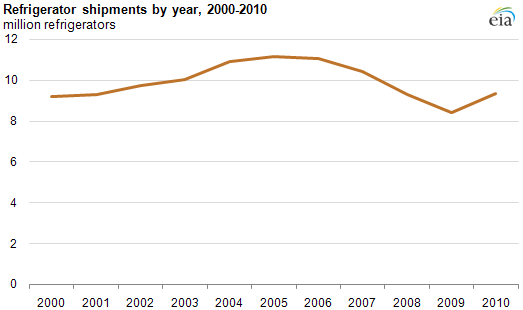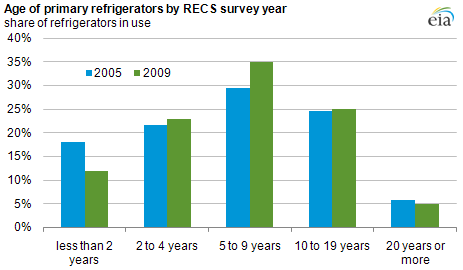
Purchase of newer refrigerators slows during economic downturn

Download CSV Data
Sales data from the Association of Home Appliance Manufacturers (AHAM) show a sharp decrease in annual refrigerator shipments from a high of 11.1 million in 2005 to less than 8.4 million in 2009 before rebounding to 9.4 million units in 2010 (see chart above).
The decline reflects both a slowdown in new housing construction and delayed kitchen remodeling. New housing construction gradually increases the stock of more efficient refrigerators. But more dramatic efficiency gains occur when newer refrigerators replace older, less efficient units. According to Appliance Magazine, more than 90% of new refrigerators go to replace existing units, but in a poor economy, homeowners often delay replacement of existing refrigerators that are still functioning.
The 2009 Residential Energy Consumption Survey (RECS) data show the effects of this trend in increasing the age of the Nation's refrigerator stock (see chart below). While the previous RECS (2005) showed that 18% of all refrigerators were less than two years old, this number fell to 12% in the 2009 survey.
As might be expected, the largest reduction in new refrigerator purchases over the years 2005 to 2009 is among the lowest income households. Just 12% of households with annual household income of less than $10,000 had a primary refrigerator less than two years old in 2009, compared to 24% in 2005. The drop was less pronounced among higher income households. For households with income above $90,000, 15% of households in 2009 had a primary refrigerator less than two years old, compared to 20% in 2005.

Download CSV Data
Decreasing sales of new refrigerators means slower adoption of new energy-efficient technology and less displacement of older, less efficient models. The AHAM reports that the average electricity consumption of a new refrigerator in 2009 was 450 kilowatt hours per year, about half the annual consumption of a new refrigerator in 1990 and only 35% of what a new refrigerator consumed in 1980.
As existing refrigerators age, they use more energy as the unit degrades. The gains in efficiency have come despite recent increases in size: new refrigerators are an average of 1.5 cubic feet bigger than older models. Because refrigerators use nearly 5% of all household energy consumed annually, a delay in replacing older with newer models slows the impact of new, more efficient technologies on overall household energy use.